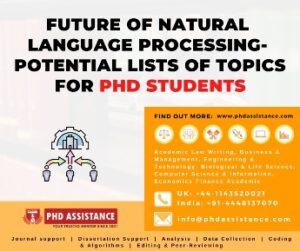Future of Natural Language Processing – Potential Lists of Topics for PhD students
The talent to develop a Good Research Topic is a skill. An instructor may allocate you a specific topic, but instructors often require you to select your topic of interest. If you have chosen Natural Language Processing (NLP) as your research topic, your research work would be incredible. We discover the opportunities (2021) and upcoming trends below.

What is Natural Language Processing : Definition: “Natural Language Processing is a theoretically motivated range of computational techniques for analysing and representing naturally occurring texts at one or more levels of linguistic analysis for the purpose of achieving human-like language processing for a range of tasks or applications”.
NLP technology facilitates the machines to read, understand, analyze, and gather appropriate sense from human languages. NLP is also recognized as Computational Linguistics, a blend of two technologies, including Machine Learning (ML) and Artificial Intelligence (AI). While human communicates with machines, everything would work faster and better because of NLP technology. 20 years ago, NLP technology was under development; hence it was only in limited use. In the past decade, NLP holds a fantastic addition to daily life but still it has only reached the lexical and syntactic processing levels for full-fledge English, with limited semantic capabilities.
NLP is the driving force behind several applications, which we are using in our daily life.
- Microsoft Word that employs NLP to identify and correct for errors in spelling and sentence organization
- Google Translate, which is a Language translation application
- Siri, OK Google, Alexa, and Cortana
- Interactive Voice Response (IVR) apps which act as personal assistant applications
| Most used NLP Tools.
|
Most used NLP resource | Long tail distributed NLP technologies | Long Tail NLP technique |
|
WordNetVerbNet
British National Corpus GermanNet FrameNET CM-1 DBPedia Homby’s Verb Patterns Google News Corpus MUC Shared Tasks Datasets Open American National Corpus Brown Corpus |
POS tagging
Stanford CoreNLP WordNet |
Word EmbeddingDoc2Vec
LSTM CNN RNN
|
| Future of NLP
As AI tries to take advantage of the technology’s prospects, NLP would get even more advanced.
Smart officialdoms now make decisions based not on data only but on the intelligence derived from that data by NLP-powered machines.
Data scientists dealing with NLP and other AI aspects rely on NLP library platforms to construct and trial their applications. The platform pool such as OpenNMT, Stanford’s CoreNLP, SpaCy, and Tensor Flow has been widely used.
Data scientists would be wiped out in the future as NLP advances along with Machine Learning, and its features such as pattern recognition, advanced analysis, and interpretation improve beyond today’s level.
The future test in NPL would be able to understand the human language. In the future, natural language processing would have to evolve in its function to become natural language understanding. Recent trends in the NLP from Scholarly Papers published in Scopus Indexed Journals
Data Sets for NLP
ConclusionNLP can analyse and bond with language-based information by making machines equipped to understand the content and substitute human tasks like abstracting, translation, classification, and mining. Moreover, NLP giving organizations a way to analyze shapeless information, customer supports communications, product analyses, and social media messages. So there are many Research Gap is yet to be determined in this field. Hence it would be a good opening for the researchers to start research in this area. References
|



